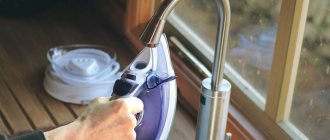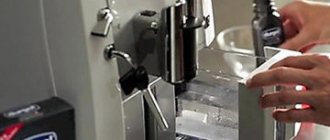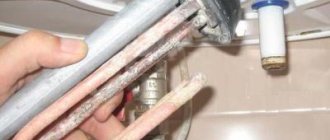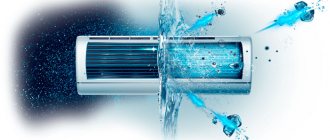Automatic water heaters are susceptible to the formation of scale, limescale and other contaminants. This disrupts the operation of the device and raises a reasonable question for many: how to clean the boiler? You can cope with the task at home yourself, having previously read the instructions for the heating device, the nuances of draining water and the disassembly rules.
The storage water heater requires periodic preventive cleaning, as it is susceptible to various contaminants that disrupt its operation and lead to increased energy consumption
The useful tips presented in the article will help you perform quick and effective cleaning with minimal effort and time.
Why do you need to clean your boiler?
If there is an odor in the water from the boiler, microorganisms are most likely to blame.
The ideal environment for them is humidity and warmth. And this is enough in a storage water heater. They also often accumulate near the heating element, where sediment from poor-quality water remains. Scale forms mainly on the heating element and the surrounding area. It is dangerous to human health. If you are going to drink water from the boiler. But even if the water is used only for domestic needs, there is no point in deluding yourself.
Lime deposits and metal have different expansion coefficients. Therefore, the heating element wears out due to constant on and off cycles. Scale also prevents the efficient transfer of heat to water, reducing the useful power of the water heater.
Reasons for the formation of deposits in a water heating tank
Scale is a hardened deposit that appears when a boiler is used for a long time. There are several reasons that contribute to the formation of plaque:
- Using too hard water. This liquid contains a lot of salt, which is gradually deposited on the walls of the boiler. Boilers in which hard water is heated are cleaned at least once every nine months.
- Strong heating of the liquid. If the water heater often heats the water to 65-70 degrees, traces of scale appear inside faster.
- Frequent use of the boiler. Water heating equipment that is used every day should be cleaned every 4-5 months.
How to clean
There are several products that can be used to clean boilers.
Folk
People who do not want to use chemical detergents use folk remedies.
Vinegar
Acetic acid is an effective solution for cleaning your water heater. When creating a working mixture, you need to dilute vinegar with water in a ratio of one to three. Then moisten a sponge in the solution and wipe the surface with plaque.
Lemon acid
A cleaning solution made from citric acid will help remove scale and clean the surface of plaque. To prepare the mixture, you need to add 5-7 grams of acid to a liter of warm water. The liquid is thoroughly stirred until the citric acid is completely dissolved.
Soda with vinegar
Sometimes the boiler is flushed with a liquid made from vinegar and soda. When creating the product, add 100 milliliters of acetic acid and 80 grams of soda to a liter container of water. Then the walls of the water heater are washed with the solution.
Professional
To get rid of scale faster, use professional detergents.
Filtero
To remove scale and clean the inside of boilers, use Filtero. It comes in powder form, which must be dissolved in warm water before use.
Filtero is very effective and helps remove dirt after the first treatment.
Topper 3031
This product is designed specifically for cleaning water heating equipment from scale deposits. The features of this detergent composition include:
- effective plaque removal;
- absence of toxic components in the composition;
- ease of use.
Bagi Kumkumit
To combat corrosion and scale, you can use Bagi Kumkumit. This is a concentrated and effective composition that can restore the surface of boilers, coffee makers, kettles and even irons. Bagi Kumkumit should be used at least once a month.
See also
TOP 20 products that can be used to clean acrylic paint at home
"Melon ZhS17"
This product should be used if the boiler has not been cleaned for several years. "Melon" is considered a highly concentrated product that removes scale, traces of fungus, mold, corrosion and many other contaminants.
"Silit"
This is a universal cleaning composition that helps clean surfaces from stubborn dirty stains, rusty deposits and scale. The advantages of Silit include the fact that it can restore the original shine of the coating.
"Eona Bio"
"Eona Bio" is a high-quality cleaner used for washing household appliances. The components included in this powder allow you to quickly remove scale. Before use, a sachet of “Eona Bio” is diluted in a liter of water.
Bagi Schumanit
A popular detergent composition used by many housewives to remove grease stains and scale deposits. You can wash your water heater with Schumanit no more than twice a month.
"Solita"
To clean boilers and geysers, many people use the Solita cleaner. The product contains components that corrode even old scale.
"Master Boiler"
This is a universal cleaner used not only in households, but also in service organizations.
It removes traces of corrosion, removes scale and cleans the surface of grease.
Signs of scale in a water heater
- Noise appears during boiler operation. Typically, this electrical equipment operates almost silently, but scale can lead to unusual sounds and humming when heating water;
- The process of heating the water to the set temperature begins to take longer. Electricity is consumed, but the heating elements cannot heat the water properly due to the layer of solid deposits;
- The boiler begins to turn off more often to prevent overheating.
Stages of descaling the boiler:
- First of all, the electrical device is disconnected from the network. The safest thing to do is not just unplug the plug from the socket, but also turn off the machine and disconnect the wires from the thermostat.
- It is advisable to wait until the water in the tank cools down a little, it will be safer to work this way.
- The water supply valve to the boiler should be turned off to prevent the boiler from filling.
- The water from the tank must be drained, following the instructions for the boiler or the water supply diagram through the boiler.
- So, the boiler is empty, the water has been drained. Now you need to get to the heating element. To do this, first of all, the decorative cover of the tank is removed; it is usually secured with several screws. You will need a screwdriver. Let us clarify: for most standard vertical models of water heaters, you can remove the heating element directly on the wall, without removing the boiler itself from its mounts. However, for example, if you have a flat model mounted horizontally, it will be inconvenient to work with. In this case, after draining the water, it is advisable to remove the tank and move it to a place where you will be comfortable working with it;
- For some models, the thermostat is removed together with the heating element, for others it is pulled out of the housing;
- There are models in which the entire stand with heating element is held on by just one nut, so it will not be difficult to remove. Other models have more nuts - five or six, but in any case they must be unscrewed to get to the heating element.
- For ease of operation, the heating element removed from the water heating tank should be unscrewed from the lid on which it is installed. First of all, we wash the heating element under cold water to wash off the top layer of scale, possibly rust;
- The remaining plaque will have to be removed differently. The simplest chemical method is to soak the heating element in water with dissolved citric acid. Remember that citric acid is recommended as a folk remedy for preventing the appearance of scale in a washing machine. She copes well with the raid. To clean the heating element, citric acid should be diluted with water in a proportion of 10 grams (one sachet) per liter of water. The heating element is simply soaked in this solution for a while; check its condition periodically. To increase the effect, the citric acid solution should be heated;
- It is not recommended to clean hard, petrified deposits from the heating element with a knife - there is a risk of damaging the top layer if you are too zealous. If you decide to use a mechanical method, you can use sandpaper, but you should also act carefully;
- Instead of citric acid or vinegar, as folk remedies, heating elements can be cleaned with special anti-scale chemicals;
- The tank itself should also be washed. If you removed it from the wall, you will have to fill it in and then pour it out manually. If it still hangs in its place and it’s convenient for you to work, then simply turn on the water supply, but do not close the hole from where you pulled out the heating elements so that the dirt pours out immediately. You should walk along the walls of the tank with a rag to remove deposits. The inside walls of the boiler are enameled, there is no scale on them, but dirt may remain;
- Abrasive substances should not be used when cleaning the tank so as not to damage the walls;
- After cleaning the heating element and the tank, you should assemble the boiler - everything happens in the reverse order. The main thing is to securely tighten the connecting screws and nuts, install the thermostat, use a pipe wrap, connect the wires;
- Then we turn on the water, fill the boiler and connect it to the network to check how it will work now.
What are the best products to use?
The basic rule for any product remains the absence of phosphates, which not only corrode the water supply tubes, but also negatively affect the internal protective coating or enamel coating. Among the most popular it is worth noting:
- Glutoclean (liquid substance for cleaning any coatings, including irons);
- Sano Anti Kalk Kettle;
- Tortilla;
- REDD Stirovit;
- InterTechKomplekt ANTINAKIPIN.
The principle of operation of all these funds remains the same
It is necessary to carefully treat the surface that is covered with scale, including paying attention to the dismantled heating elements. After this, after the period of time indicated on the package, the boiler tank is washed with several buckets of water and wiped with a rag.
If scale remains on the walls and, especially, the bottom, the process must be repeated, increasing the exposure time by another 10-15 minutes.
During the cleaning process, the contents of the boiler can be poured into the bathtub or washbasin, since descaling agents are selected for their environmental friendliness and neutral effect on all types of materials, including cheap acrylic.
How to clean a boiler algorithm of actions
- Disconnect the boiler from the power supply.
- Drain the water.
- Clean the boiler.
- Carry out assembly and connection.
Disconnecting from the network and draining the water
To disconnect the water heater from the local power supply, you need to turn off the machine and disconnect the wires from the thermostat. After this, you can proceed to draining the water.
To do this, take a hose or thin tube, install it at the water collection outlet, on the safety valve, and open any hot water tap. This will allow air to enter the check valve. The drain pipe must be connected to the toilet or bathtub.
If the boiler does not have a safety valve or it is broken, then it must be installed later. Then the first step is to shut off the flow of cold water into the boiler and disconnect the supply hose. After this, connect the tube to the ball valve. Then we perform the steps described above.
We recommend: What to do if water drips from a heating boiler, how to stop the leak yourself in gas, solid fuel and other models with different heat exchangers
How to drain water from a boiler
It is very convenient when the water heater is installed above the bathtub or in another place where you can freely place a large container under it. Then you can not waste time on this procedure, but drain the water immediately before cleaning the boiler, while removing the heating element. But it is worth warning that the design of some models of storage units may create difficulties for you during such emptying.
Advice. It is convenient to drain the water while removing the heating element in those water heaters where it is screwed directly into the tank. In other models, you have to unscrew several nuts holding the flange with the heating element, then it is better to empty the container in advance.
If the boiler is connected to the water supply correctly, as shown in the diagram, then there will be no problems with emptying for subsequent cleaning. The algorithm is like this:
- disconnect the device from the electrical network and close the general water supply tap;
- turn off the cold water tap near the heater, and open the hot water valve on the nearest mixer and wait until it drains;
- attach a tube directed to the sewer to the drain fitting, open the tap and drain the water.
When there are no taps or drain pipes, you can try to empty the tank through the safety valve. But in this case, cleaning the water heater will take a whole day. So it’s better to wait until the water in it cools down, and then act according to the algorithm outlined.
But since there is no fitting, you need to disconnect the hot water pipe from the boiler and place a bucket. To allow water to flow, carefully unscrew the safety valve. As soon as air begins to flow into the container, water will flow out of the nozzle. The valve can be removed completely and the intensity of the jet can be adjusted by plugging the “cold” pipe with your finger.
This way you will empty the tank relatively quickly. During reassembly, do not forget to assemble the circuit properly so as not to waste time next time.
Descaling
How to properly clean a boiler from scale is a rhetorical question. The fact is that you can do the cleaning yourself, and therefore the quality of the cleaning will depend on the quality of the work performed.
There is only one nut inside the water heater that needs to be unscrewed. She holds the heating element with a metal plate that needs to be removed.
After draining the water, the boiler must be removed from its mounts and placed on the floor, after which the thermostat must be pulled out. The ARISTON TI TRONIC 100 V model clearly shows how it is possible to clean the boiler. In order to get the heating element, you need to push the flange inward and then pull it out.
After removing the heating element of the boiler, simply use your hand or a rag to remove all accumulated scale from the tank. The tank is enameled from the inside, so there is practically no scale on the walls. Next, the tank can be rinsed under high pressure water or the walls can be wiped well with a rag.
After this, you need to properly assemble the boiler. To do this, we perform the same algorithm as during disassembly in reverse order and connect water and electricity.
Some problems with heating element
If the heating element is in poor condition, for example, there is heavy scale on the heating element, it will have to be replaced. Cleaning in such a situation is so problematic that it is easier to buy a new heating element. You need to buy a similar heating element with the same power.
When purchasing, look at the length of the contacts connecting to the thermostat (it should be identical to the old heating element). If the distance between the terminals is different, there may be no contact with the thermostat.
If the heating element is still normal and you managed to clean it, you can take a risk and try its further operation. Only you can decide how to clean your boiler. But it is undesirable to take risks, because safety depends on it: in case of aging, electric heaters tend not only to receive electric shock, but also to explode.
Magnesium anode in the boiler
– another important detail in the question of how to properly clean a boiler. It is located near the heating element and is destroyed during operation, so it is advisable to carry out regular replacement. To replace the anode, simply unscrew it. Next, install a new one in this place, which you can purchase in the store when purchasing a new heating element.
This procedure, as well as cleaning the boiler, should be carried out every two years. The service life of the anode depends on the frequency of use of the water heater.
Flushing the boiler without removing it
There are several ways to descale your boiler. It is impossible to say which one is more effective - it all depends on the quality of the water and the substances it contains. You may have to try them all. These methods will also help to flush an indirect heating boiler.
Method No. 1 - citric acid
You will need a large amount of citric acid, at the rate of one 20-gram sachet per liter of boiler volume. For example, a 50-liter water heater will require 0.8 kg of citric acid.
Actually, the procedure:
- Dilute citric acid in a ratio of 1 to 3 with water;
- Pour the resulting mixture into the boiler through the water supply hose;
- Connect the hose to the water pipe;
- Turn on the boiler and wait until it is completely filled;
- Set the maximum temperature and wait until the water heats up;
- Drain the water.
Method number 2 - vinegar
To clean, you will need vinegar or 70% vinegar essence. If you use regular 9% vinegar, you will need 100 ml for each liter of boiler volume.
If you use 70% essence, then you need 13 ml for each liter of boiler volume. For a 50-liter bottle you need to take 650 ml of essence. But before use, dilute it in 2-25 liters of plain water.
How to descale a boiler with vinegar:
- Pour vinegar or essence solution through the water supply hose;
- Connect the hose to the water supply and completely fill the boiler;
- Turn it on to maximum temperature;
- Wait until it warms up completely and leave it like that for 30-35 minutes;
- Drain the water.
Method number 3 - baking soda
To descale your water heater, you will need baking soda (NaHCO3) in the amount of 25 grams per 1 liter of tank volume. It must be completely diluted in water in a ratio of 1 to 12 at a temperature not exceeding 55 degrees. If the baking soda gets hotter, it will decompose.
Usage:
- Pour the soda solution into the boiler through the water supply hose;
- Turn on the water heater, wait until it fills;
- Set the temperature on the regulator to 55 degrees and wait for the water to heat up;
- After the water has warmed up, leave the boiler on for an hour;
- Drain the water.
We recommend: Design of a circulation pump for heating: how it works, how it works in the system, principle of operation, where it should work, design
By professional means
This method is less effective than the mechanical one, but it is easier to use and does not involve the risk of element breakage. Before starting descaling work, it is recommended to remove the water heater from the wall and clean the inside of the tank. The container is filled with a special solution containing a chemical.
For water passing through rusty water pipes, products containing phosphoric acid are recommended. Experts recommend getting rid of scale that destroys the water heater using:
- Cillit ZN/I;
- Aipakon;
- AlphaPhos;
- Thermagent Active.
For equipment that has served for more than 2-3 years, descaling agents based on other acids are not recommended.
You can clean the inside of the water heater using a surfactant-based product. Steeltex and Alumtex are considered the best in this segment.
Carefully read the instructions on how to clean your water heater from scale deposits! The manufacturer indicates the exposure time of the solution on the packaging!
In most cases, you should prepare a solution: mix the product with water in the required concentration. Open the cold water supply to the boiler, drain hot water by 2/3. Using the reverse connection of the water heater, it is necessary to pour the solution inside the tank. Leave for 5-6 hours, drain through a hot running tap.
Mechanical method
When you finally have a heating element in your hands, you can evaluate the quality of your tap water. Don't wait for it to dry. Carefully remove the wet layer of scale with a wire brush.
If you don’t have such a tool on your household, you can clean it with a wooden spatula or knife. After the operation to remove plaque, polish the heating element with sandpaper. Remember, the cleaner the surface, the less electricity the water heater will consume.
Cleaning the anode and heating element
The top of the heating element is most likely covered with dirt, which can be easily removed by hand. Underneath there will be a layer of scale (calcium, lime). You'll have to tinker with him.
It is best to remove the outer layer of dirt with a wire brush. knife, etc. But do this carefully so as not to damage the metal of the tube. It’s not that it’s too fragile, but still... When the main contamination has been removed, you can continue cleaning using special means.
Nowadays it is easy to buy a descaling product. Any of them is suitable for heating elements. But the magnesium anode can only be cleaned by hand. To do this, use the same metal brush or sandpaper.
You can finish cleaning a wet heating element using a folk remedy. Place it in a container and estimate how much water you will need to completely cover it. Measure the required volume and add to it:
- Vinegar: 100 ml per 1 liter of water;
- Soda: 50 g per 1 liter of water.
Leave the heating element to soak for a day.
How to clean a boiler with disassembly
Owners of small-volume boilers are recommended to disassemble the unit in order to completely clean the parts from scale and return the device to its initial efficiency indicators.
It is important not to damage the machine controls during the process. To carry out work on the water heater, you will need the following tools:
- open-end wrenches of different sizes;
- screwdrivers of various shapes and diameters;
- Adjustable wrench;
- standard plumbing key.
To clean a water heater from a layer of scale, it must be disconnected from the electrical network and shut off the flow of cold water. Wait a couple of hours so that the water temperature drops and does not cause burns. Open the hot water tap and empty the tank.
Next, carry out work to remove scale according to the following scheme:
- Disconnect the hot water supply hose and open the appropriate tap on the mixers to drain the residue.
- Carefully disconnect the power cable with terminals from the heater and thermostat.
- Start unscrewing the flange to which the heating elements are attached, allowing the remaining water in the tank to gradually drain out. Remove completely.
Take a photo of the internal connections of the water heater to avoid confusion with its electrical diagram.
The removed heating element must be descaled. You need to remove the layer with a sharp tool. An object with an abrasive surface, a chisel or a knife, is suitable for this purpose. Remove carefully, being careful not to leave damage to the tube.
The storage tank should be cleaned of mucus and other contaminants using a plastic scraper or brush. It is not recommended to put pressure on the body or rub it hard, as this can damage the walls and break the seal.
After descaling work, it is necessary to reassemble the water heater in the reverse order of dismantling.
Examine the electrode for wear. Damage can be determined visually - reducing the length of the rod to 20 cm.
Before installing the water heater, it is recommended to clean and treat the rubber parts of the boiler with sealant. This will prevent water leakage during operation and reduce the risk of scale formation.
After installing the heating element, you must:
- Hang the water heater on the wall.
- Connect to the pipeline.
- Turn on the hot water tap, open the cold water supply.
- Fill the boiler with water and check for leaks.
- Reinstall the thermostat and connect the wires.
- Replace the safety valve.
- Connect the device to the network.
If you regularly clean the water heater from scale and rust, the process will go quickly and will help extend the life of the device.
Disassembling the water heater
The device should be disassembled by turning it upside down. Next we proceed in the following order:
- remove the front panel by releasing the latches that secure it and picking it up with a screwdriver;
- pull the handle of the temperature regulator and carefully remove it;
- loosen and remove the screws that secure the panel;
- disconnect the cable through which the device is powered (it is held on by three screws);
- We remove the temperature regulator and the flange that ensures water heating.
How to clean the heating element from scale?
The heating element is located on the flange, which we removed from the water heater last when we disassembled the device.
Having examined the heating element, we will most likely find a thick layer of scale and other dirt deposits on it. The most effective way would be to simply remove this plaque mechanically. To do this, arm yourself with a not very sharp knife or cutter and carefully scrape off the dirt, trying not to damage the metal surface of the heater. After this, we install the heating element in place and assemble the boiler in the reverse order.
Cleaning the tank
It is recommended to remove such contaminants from the inner surface of the tank only by chemical means, since otherwise there is a high probability of damaging the tank. You need to proceed as follows:
- manually remove all dirt from the tank, which easily comes off;
- Pour cleaning agent diluted in water into the tank;
- we wait the allotted time;
- pour water from the tank;
- remove any remaining dirt with a soft sponge;
- Rinse out any remaining dirt and cleaning agent from the tank.
When cleaning the tank, do not use sharp objects or sandpaper, or touch the magnesium rod.
Reassembling the boiler after cleaning
After cleaning and disassembly is completed, the water heater is reassembled. All actions are performed in reverse order:
- The thermostat with heating element is put in place and the flange is screwed on;
- the boiler is hung on the wall;
- cold water and hot water pipelines are connected to the nozzles;
- the storage tank is filled with water and tested under pressure to ensure there are no leaks;
- if the test is successful, connect the electrical cable, put the decorative cap in place, and then try to heat the water.
During reassembly of the water heater, it is important to carefully inspect the gaskets. They are well cleaned from dirt, but it is better to buy new ones
To prevent leakage, the gaskets are lubricated with sealant.
Features for devices from different manufacturers
The general scheme for removing the water heating element may have slight adjustments depending on the brand of the boiler. They are determined by the individual structure of the device and the method of installing the heating element. The following boilers have disassembly features:
- Ariston. To remove the cover with the heating element, you must first insert it inside the housing. If the part does not give in, rock it slightly and try again. The heating element is taken out sideways, as it has a curved shape. On some models, this part needs to be turned counterclockwise.
Gorenja. To remove the front panel on the tank, you need to lightly press its lower edge and pull it towards you.
Once the latches have engaged, the panel is removed. The boilers of this company are heavy, so it is better to lift and turn the device together.- Polaris. Models of this brand are distinguished by the difficulty of removing the heating part. First, the retaining bracket in the device is unscrewed and only after that the heating element is removed. It is taken out at an angle, as if taking it to the side.
- Atlantic and Termex . In water heaters of these brands, first unscrew the nuts located around the circumference of the tank. Then remove the fastening washer. The flange on which the heating element is fixed is lowered down. The heating element is taken out carefully, using loosening movements.
Boiler care rules
To ensure long-term and efficient operation of a storage water heater, you need to know and follow several simple rules:
We recommend: Flushing the heating system of an apartment building
Since the resulting scale and organic deposits are a consequence of the increased hardness of the consumed water, installing additional filters directly in front of the inlet pipe significantly increases the life of the boiler.
Proper and timely cleaning of the device will reduce heating time, extend the service life of the heating element and reduce energy consumption.
During operation, it is necessary to constantly monitor the condition of electrical wiring and grounding.
Do not use a faulty unit.
If any malfunctions are detected, immediately contact your nearest service center.
Important!
It is strictly forbidden to connect an unfilled water heater to the electrical network.
In most cases, failure of storage water heaters is associated with violation of maintenance intervals or non-compliance with operating rules. Timely cleaning of water heater elements from scale not only ensures effective heat exchange, but also increases the service life of the heating element.
Do-it-yourself cleaning of water heaters from odor inside
Many owners of water heaters notice over time that the heated water begins to smell terribly. This unbearable smell may have several reasons:
- Dirty water is supplied to the boiler. If there are a lot of foreign impurities in the water, especially hydrogen sulfide, it emits an unpleasant odor.
- There are specific bacteria and fungi in the tank. Such living creatures are born in the limescale deposits on the walls of the container. As long as there are not many microorganisms, the smell of the water does not change. But over time, their number increases, and the water begins to stink.
- Cheap or damaged water supply. Low-quality tubular plastic transfers its chemical smell to water. And old metal water pipes are ideal for the life of bacteria and fungi.
Water with hydrogen sulfide is impossible to smell
There is a way to determine which of these cases occurs:
- Run cold tap water for 5 minutes. Then place a clean bottle under the stream and close it after filling. After half an hour, you need to open the bottle and check the smell of the water. If it smells bad, there is a problem with the pipes or water.
- If cold water from a bottle smells normal, you need to look for the reason in the boiler itself. To do this, you again need to fill the plastic container, but only from the hot tap closest to the water heater. We wait 30 minutes and smell. If you can’t breathe from the bottle, it means there are harmful microorganisms in the tank.
In order to eliminate the unpleasant odor due to bad water or rusty pipes, you can do the following:
- Install a filter that removes bad-smelling gases from the water.
- Complain to the SES about the poor quality of tap water.
In the first case, you don’t have to wait for someone to come and fix the problem. Therefore, if you can’t stand the smelly water, it’s easier and faster to install a filter.
Problems with microorganisms in the boiler are solved differently:
- Sterilization of the tank. The water in the boiler is brought to a boil and remains in this state for a long time.
- Removing scale from a water heater (see above). This will destroy the favorable environment for the proliferation of microbes and bacteria.
To prevent smelly water from coming out of the boiler again, you need to follow simple preventive measures:
- Do not leave water in the water heater when it is not in use for a long time.
- Periodically descale the tank.
- It is advisable to install a filter.
- Pay attention to water quality. If necessary, contact the sanitary and epidemiological station.
Use of auxiliary chemicals or folk remedies
Disassembling/assembling the device can be difficult and time-consuming, and mechanical cleaning may be ineffective. In this case, the tank can be cleaned without disassembling using cleaning products. Household chemicals include special products:
- Master Boiler;
- Nast;
- Cillit;
- Topper;
- Cinderella Antiscale.
All of the listed cleaners have the same properties and are used in a similar way:
- the boiler is emptied by a third;
- the solution is poured through the hose attached to the fitting;
- The mixture is kept inside for several hours.
After this, the tank is rinsed several times, draining and filling with water. During the last rinse, the device must be turned on, warmed up and the water drained. Only after this can the boiler be used for its intended purpose. Cleaners prepared independently using improvised means are also used:
- citric acid;
- vinegar;
- soda;
For a home cleaner, you will need about half a kilo of one of the listed products, which must be dissolved in two liters of water.
Important! When using soda-based cleaners, it is important to ensure that the powder is completely dissolved. Otherwise, invisible microcracks may appear that can affect calcification.
When is the best time to contact a specialist?
The design of the boiler is not complicated, but not in all cases it is possible to cope with problems and clean it yourself. Calling a plumber is justified if there is a water leak or the device does not turn on.
A qualified specialist will carry out diagnostics using a special tester without disassembling the water heater. The malfunction of the heating element can only be determined using the device. If a part burns out due to scale, the technician will replace it. Repair of a failed tube is not carried out.
The cause of the malfunction may lie in the temperature sensor. If after the measurements it turns out to be faulty, you will have to purchase a new water heater.
The specialist will also inspect other systems and help identify faults. After repair, the boiler will be cleaned of deposits using mechanical or chemical methods. The choice depends on the customer and the volume of the tank.
Cleaning the boiler from scale means extending its service life and ensuring proper operation of all device control systems. Regular flushing of the water heater will prevent the formation of a dense layer of scale, which reduces efficiency. Experts recommend combining the chemical method with the mechanical method to achieve maximum results. Analysis is carried out once a year, treatment with chemicals every 3-6 months.
Useful tips for cleaning your water heater
Before you rush into battle, trying to remove all the scale that you find inside the device, we recommend that you listen to our advice.
- Do not start cleaning the boiler alone! Even the most compact storage water heater still weighs a fair amount. Therefore, it is better to ask a friend to help you - this will help avoid both possible injuries and damage to the device. Remember that storage models may fail if dropped.
- Turn the appliance on and off from the mains only if there is water in it! Please remember that turning on the unit empty may result in a fire.
- If you have successfully completed all the cleaning and replacement of components, then fill the device with water and wait 2-3 hours! It happens that the flange of the water heater may leak. If you did everything correctly, there are no leaks, then you can breathe out and use it without fear.
- Wear personal protective equipment if you use a chemical cleaning method. Believe me, acid fumes are unlikely to be beneficial to your health.











